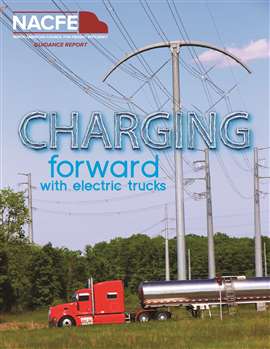NACFE releases second guidance report on charging infrastructure
05 July 2023
 The 2023 NACFE guidance report, “Charging Forward with Electric Trucks,” considers what’s necessary to build a charging infrastructure for battery-electric vehicles. (Photo: NACFE)
The 2023 NACFE guidance report, “Charging Forward with Electric Trucks,” considers what’s necessary to build a charging infrastructure for battery-electric vehicles. (Photo: NACFE)
A new guidance report, titled “Charging Forward with Electric Trucks,” is exploring considerations for building a charging infrastructure for battery-electric trucks currently in production for freight delivery.
Released by the North American Council for Freight Efficiency (NACFE), Electric DEPOT and RMI, the new report is the second generation of a 2019 NACFE report, titled “Amping Up: Charging Infrastructure for Electric Trucks.”
According to the new report, infrastructure for electric vehicles includes not only the chargers themselves but also the interrelated system of vehicles, duty cycles and electric utilities.
“While there are a great many factors that impact the scaling of electric vehicles for hauling freight, careful planning and collaboration will help make the process go more smoothly,” said Mike Roeth, NACFE executive director. “The guidance in this report should give fleets confidence to move forward with adding more electric vehicles to their operations.”
NACFE said the acceleration of the movement toward electrification of commercial vehicles led to the demand for this new report.
“This step-by-step guide allows fleets to see at a glance the factors they need to focus on as they add more battery-electric vehicles,” said Rob Graff, NACFE senior technical advisor. “We expect this to be an invaluable resource for fleets just as the Charging Procurement Roadmap from our first infrastructure report was.”
NACFE said the report’s study team developed six key conclusions:
- Electric trucks and chargers must work together. Charging infrastructure is just one part of a system integrating your vehicle needs, electricity rate structure, and the timing and cost of bringing additional electricity to your site.
- Your utility is a key partner. Electric trucks use a lot of power, probably more than you currently have available. It is essential that you meet in person with your utility as soon as you begin thinking about electric trucks, as they will be your partner in providing the power you need. Increasing power delivery to your facility can take time. Coordinate closely with your utility and modify your implementation schedule to assure you have power when you need it.
- Use and design greatly affect charging cost. In general, spreading charging over the longest time and using lower charging power makes both the charging equipment and electricity costs lower and maximizes battery life. Design your charging strategy to make the best use of vehicles’ scheduled downtime.
- The transition requires staff and attention. The transition to BEVs and associated charging infrastructure requires attention and expertise. You need to have a single point of contact with internal and external authority and to lead the project.
- Consider other charging business models. You may wish to explore options other than owning and operating your own charging infrastructure as a stopgap or long-term model.These include Charging as a Service (CaaS) and Trucking as a Service (TaaS). CaaS provides a contracted service to provide all your charging, either on your site or at a nearby shared location.
- Other key considerations. There are a host of other things to consider when it comes to EV infrastructure, as well as additional developments to be aware of:
- Grants, incentives and subsidies are at an historic high offering a window of opportunity for fleet electrification
- If you do not own your facility, talk with your landlord early
- Microgrids are emerging from the shadows
- Reliability and interoperability of chargers must improve
- Training a skilled workforce to support and service BEVs and charging hardware is critically important
- Processes to improve electricity transmission/distribution infrastructure must be improved
- BEV makers must increase miles per kilowatt, reduce vehicle costs and weight, and increase payload and reliability
STAY CONNECTED




Receive the information you need when you need it through our world-leading magazines, newsletters and daily briefings.
POWER SOURCING GUIDE
The trusted reference and buyer’s guide for 83 years
The original “desktop search engine,” guiding nearly 10,000 users in more than 90 countries it is the primary reference for specifications and details on all the components that go into engine systems.
Visit Now
CONNECT WITH THE TEAM










